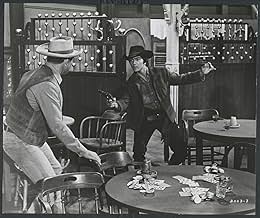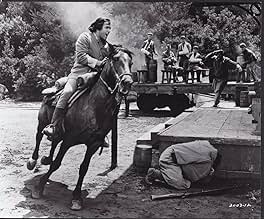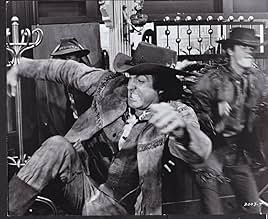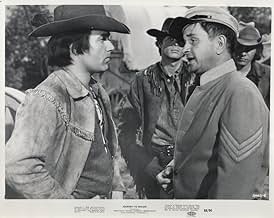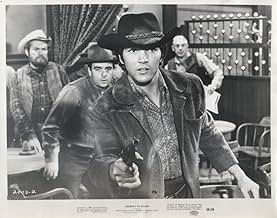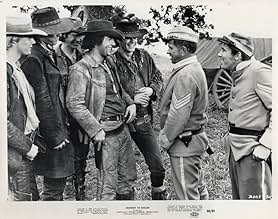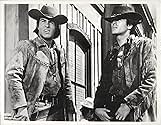Na segunda metade do século 19, os Estados Unidos viveram uma fase de intensa luta armada dentro de seu país. Logo depois de conquistarem o Oeste, uma violenta guerra civil estourou no inter... Ler tudoNa segunda metade do século 19, os Estados Unidos viveram uma fase de intensa luta armada dentro de seu país. Logo depois de conquistarem o Oeste, uma violenta guerra civil estourou no interior.Na segunda metade do século 19, os Estados Unidos viveram uma fase de intensa luta armada dentro de seu país. Logo depois de conquistarem o Oeste, uma violenta guerra civil estourou no interior.
- Little Bit Lucket
- (as Michael Vincent)
- Sgt. Mercer Barnes
- (as Noah Beery)
- Direção
- Roteiristas
- Elenco e equipe completos
- Produção, bilheteria e muito mais no IMDbPro
Avaliações em destaque
The story and the theme are virtually identical to a 1959 German film "Die Brucken", in which seven just inducted teenage boys watch as cynical Wehrmacht soldiers evacuate their town ahead of approaching American troops. Full of enthusiasm for the "blood and honor" of patriotic ideology, the seven boys stay to defend a useless bridge. Both films are somewhat unusual anti-war pictures because the enemy is essentially faceless and the theme derives more from the tragedy of easily influenced and manipulated young people.
Aside from the obvious California scenery (which cannot even remotely pass for Texas or Mississippi), the absurd physical miscasting of John Doucette as General Braxton Bragg, and a rather weak battlefield sequence; "Journey to Shiloh" is reasonably accurate historically. I'm from Tom Green County, Texas (just west of Concho and Menard Counties- where the characters are from) and the boys' journey to get into the far away war was not uncommon for West Texas; where young men went to war seeking adventure without much clue what the fight was really about.
Calling these actors "boys" requires considerable suspension of disbelief as most of them were in their mid to late 20's. James Caan is the leader, the story is told from his point of view and he gets the vast majority of the screen time. Other sixties notables in the group are Michael Sarrazin, Paul Petersen, Jan-Michael Vincent, and Harrison Ford (who gets the least screen time-yet would become the most famous).
Interestingly, even the remaining two had their claims to fame. Michael Burns played Benjie "Blue Boy" Carter in the all-time camp classic "Dragnet" episode about the evils of LSD; the drug caused him to paint his face blue (years before Mel Gibson). And Don Stroud's portrayal of Lamarr in "Joe Kidd" might be the finest piece of overacting in cinema history.
Other notables in the cast are Rockford's dad and Ann Sothern's daughter Tisha Sterling. Sterling was an extremely promising actress in the late sixties (and my personal favorite) who in an ideal world would have had a lot more good roles. Here she plays a patriotic southern belle named Airybelle Sumner, who in the film's best scene inspires the boys (men) to fight for the noble honor of the south. They soon learn that her view of the south is somewhat at odds with reality.
"Journey to Shiloh" does not deserve its obscurity. It has its faults but is gripping entertainment with an important message. Considerably better than most films from the time period.
Then again, what do I know? I'm only a child.
Old timers like Noah Beery, Jr and John Doucette were used to the genre, and add to the film greatly.
Newcomers (at the time), like James Caan, Michael Sarrazin, Jan-Michael Vincent, Harrison Ford, and Robert Pine would all go on to better things, but they do well here, too. Added to the mix is a TV leftover, Paul Peterson, who's part is small, but well-done.
It was obvious that the film was cast and made like it was because of the growing youth market (Wild In The Streets, Psych-Out, Savage Seven, and Chubasco, among others).
I love this film very much, and wait patiently for a widescreen DVD to be released. I can only hope I live long enough to see it happen.
James Caan plays the main protagonist, "Captain" Buck Burnett, while the other six "teens" (all well into their 20s) are Michael Sarrazin, Don Stroud, Jan-Michael Vincent, Michael Burns, Paul Petersen and, believe it or not Harrison Ford, a full nine years before his breakthrough with Star Wars, but don't get too excited as he gets the least screen time of the bunch.
On the downside, Universal was huge on TV movies at the time and so "Journey to Shiloh" looks like a TV movie; in fact, it was directed by one of their TV movie directors. So don't expect the cinematic scope of contemporaneous Westerns, like "Duel at Diablo," "Bandolero!," "Hang 'Em High" and "Shalako." It looks serviceable, but also phony and stale. A big part of the phoniness is due to the fake Southern countryside, as the movie was shot in Agoura and Thousand Oaks, California, but takes place in East Texas, Louisiana, Mississippi, Tennessee and adjoining regions. No matter how you slice it, California doesn't look like the deep South, not to mention the studio sets. Another issue is the movie's cartoony vibe. Things that would ordinarily take much longer occur with the quickness of a comic book.
Despite these glaring flaws, I found myself ignoring them in favor of the story, particularly as it moved along. You feel like you get to know most of the gang by the end of the movie, Harrison's character being the biggest exception. The "boys" grow from wide eyed youngsters to hardened men over the course of the movie, the biggest rude awakening of course being their baptism into soldiering and war.
Speaking of which, I really enjoyed the last third of the film that involves the youths joining up with Bragg's brigade, the ensuing warfare, deaths, injuries, possible desertion and aftermath. Although decidedly comic booky the movie offers a unique glimpse of being a Confederate soldier.
The film features no less than four beauties, albeit all relatively short roles: Tisha Sterling as Airybelle Sumner; the un-credited Susanne Benton as the blond saloon girl, Lucy; Brenda Scott as the brunette saloon girl who falls for Buck; and a nurse (Eileen Wesson).
FINAL WORD: Someone criticized "Journey to Shiloh" for its obvious low-budgeted faults by pointing out that it's no "Magnificent Seven" or "The Wild Bunch." While this may be technically true I found myself enjoying "Journey to Shiloh" more than these heralded Westerns. Yes, the movie has the unmistakable gloss of one of Universal's factory-made television movies, but it's strong in characters and story, cartoony or not. This is likely because the movie's based on Henry Wilson Allen's excellent novel (aka Will Henry). Some call it an "anti-war movie," but this isn't really true; it's simply a "showing-soldiering-and-war-the-way-it-really-was" movie.
The film runs 101 minutes.
GRADE: B
The film does seem to reflect the unhappiness and questioning of the then ongoing Viet Nam war, yet our band of 7 from Texas for the main, soldier on until death accomplishing nothing but filling their duty and being honorable men. They come to question slavery and therefore the basis of the war but aren't able to do anything about it. In that sense the film is believable. I like Caan's performance although not his haircut. He is the strong, silent type but with plenty of charm.
It's his movie and he does alright. A great cast of actors not yet at their peak.
Você sabia?
- Curiosidades"The Yellow Rose of Texas", heard as a theme throughout the film, was popular among soldiers in the Confederate Army's Texas Brigade during the American Civil War. Gen. Hood introduced it as a marching song when he took command of the Army of Tennessee in 1864.
- Erros de gravaçãoBrenda Scott's hairdo was a "That Girl" Marlo Thomas replica circa 1968. No woman on earth wore that hair style in 1862.
- Citações
[Buck's men encounter a slave for the first time]
Jacob: My, my. You're a long way from home.
Little Bit Lucket: We're going to be longer. We're headed for Virginia.
Jacob: Ain't that nice.
Little Bit Lucket: You know, where the war is. We're goin' to fight Yankees.
Jacob: I hear tell the Yankees is fightin' us. I hear tell they're mighty mean! Oh, I reckon we'll whip 'em.
Buck Burnett: We?
Jacob: Yessir - us Southerners.
- ConexõesFeatured in Jan-Michael Vincent Is My Muse (2002)
- Trilhas sonorasThe Yellow Rose of Texas
(uncredited)
Traditional
Arranged by David Gates and Gene L. Coon
Tune heard as a theme throughout the film and also used as the music for the song heard at the start and end of the film
Principais escolhas
- How long is Journey to Shiloh?Fornecido pela Alexa
Detalhes
- Data de lançamento
- País de origem
- Idioma
- Também conhecido como
- Héroes sin gloria
- Locações de filme
- Empresa de produção
- Consulte mais créditos da empresa na IMDbPro
Bilheteria
- Faturamento bruto nos EUA e Canadá
- US$ 407.500
- Faturamento bruto mundial
- US$ 407.500
- Tempo de duração
- 1 h 41 min(101 min)
- Cor
- Proporção
- 2.35 : 1



